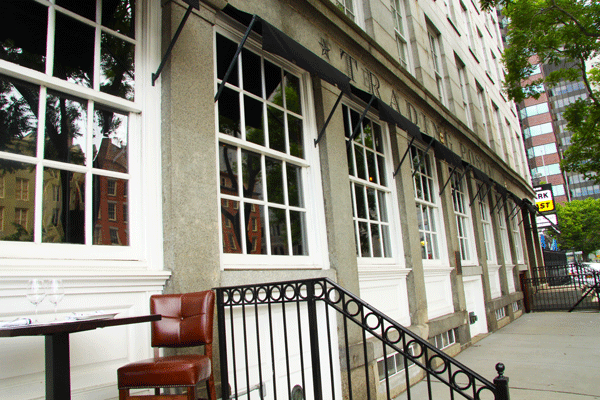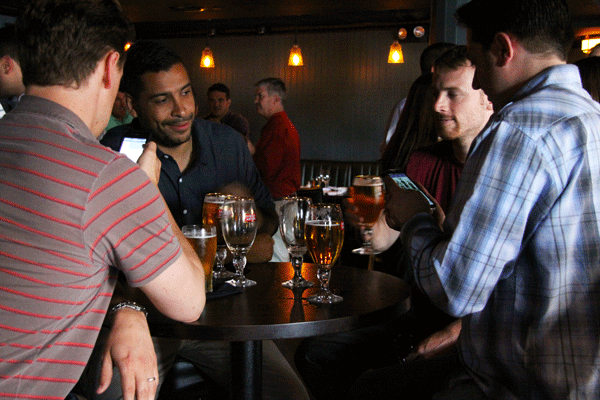
Trading Post on John St. hopes to open an outdoor cafe, but at least a few of the building’s condo owners oppose it.
By CYNTHIA MAGNUS | The owners of the newly opened Trading Post restaurant at 170 John St. near the South Street Seaport want to add outdoor dining this summer. Despite a heated exchange with two building residents at the July 1 meeting of Community Board 1’s Financial District Committee, the eatery’s co-owner Sam O’Connor says he is hopeful for an agreement.
The dispute erupted when the two residents alleged that the building was not notified of the proposed outdoor cafe. They also said that they are worried about noise. Ro Sheffe, the committee’s chairperson, requested that O’Connor postpone submitting his revised State Liquor Authority application until cooler heads could prevail.
O’Connor said that relations with most residents are good and that several use the restaurant. He acknowledged though, that the application “was probably done the wrong way around, we should have gone to the building first.”
The protesters refused to allow their names to be published for this story despite their public outcry. Their suggestion that the Trading Post lease space for its outdoor seating on an adjacent parking lot at the corner of South and John Sts. was one O’Connor dismissed, saying it would likely add about $9,000 to his monthly rent.
He said Trading Post is the only restaurant in the area without outdoor seating and he hopes to still work something out.
“It’s an economic issue for us,” he said. “We’re not established….It’s a problem because we don’t really have lighting on the place,” explaining that installing lights on the exterior of the building is prohibited because it is landmarked.
Co-owner Richard Sheridan said last month’s opening was delayed six months because of post-Sandy rebuilding, which cost about half a million dollars. The basement and main floor were flooded and the electrical and boiler rooms were destroyed.
“Still, it could have been much worse,” said Sheridan, explaining that all the interior furniture and fittings had been purchased and were about to ship when Sandy was forecast, so they were able to halt delivery.
Sheridan said their 15-year lease for $30,000 a month was signed Feb. 1, 2012 with Pat Cooney, the 170 John St. board member who owns the 10,000 square foot, multi-level commercial space, former home to the Yankee Clipper restaurant.
The condominium has 14 residential units. One of the occupants who came to protest at the C.B. 1 meeting but does not want her name publicized and is not on the building’s board said the next day, “It’s the entire condominium who owns the space and it would be up to them to decide what is done with it.”
Sheridan acknowledges that he and his three partners will likely have to pay additional rent to the building’s board to use the recessed sidewalk area.
“We built something beautiful here,” said Sheridan, “We want the Trading Post to be a weekend brunch place for neighborhood families as well as a tourist destination. He added, “In hindsight, it would have been prudent to go to the building first but we wanted to find out from a legal standpoint what was required [to add outdoor tables].”
Sheffe characterized support for independent business operators as the “touchstone” of the C.B. 1 Financial District Committee.
“It’s balancing commerce with quality of life — anything we can do to aid small businesses, unless it presents a clear annoyance to the community,” he said. “We heard from two people, and we will definitely take that into consideration…but I’m not sure of how representative their views were of all the residents.”
Anyone is welcome to write to the State Liquor Authority and express an opinion of a license applicant, said S.L.A. spokesperson William Crowley.
He also explained that operators often do not know what their future needs will be, so it is common for alterations to an existing S.L.A. license to be presented to the agency as needed. Altered applications are required even for mundane purposes such as utilizing a previously unused room to store alcohol.
Because the outdoor dining area would be on the building’s property, the restaurant does not need a sidewalk cafe permit from the city.
Sheridan said he would like to operate six four-person tables along the sidewalk outside the restaurant from noon to 9 p.m., and that outdoor tables would be invaluable as advertising even when not in use.
“A few attractive tables would go a long way in letting people know we are open for business.” Sheridan said the absence of city lighting on the block is a problem. He said he would also seek permission to possibly wrap sidewalk trees in white lights.
A city Dept. of Transportation spokesperson did not respond to emails and phone calls about John St. lighting conditions.
Sheridan said the outdoor cafe would not be noisy. A doorman is responsible for outdoor security and to monitor noise and cigarette smoking from 6 p.m. to closing, Sheridan said.
Pat Moore, a C.B. 1 Financial District Committee member who attended the July 1 meeting and also chairs C.B. 1’s Quality of Life Committee, said afterward, “We’ve got to be fair to both sides. We’re equally concerned about quality of life for residents, but also about businesses. These are local businesses that we patronize.”
The plan now for O’Connor, Sheridan, and two partners is to negotiate along with Cooney for the use of the outdoor area with the rest of the building’s board, and then return to C.B. 1 before its July 30 full board meeting.



































